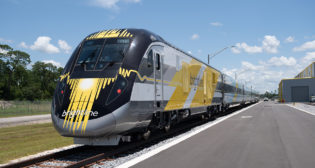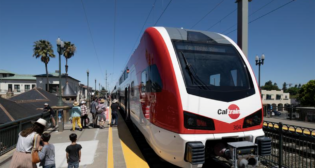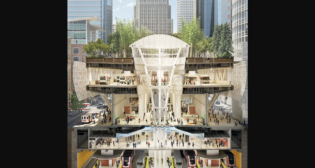
RAIL TRANSIT’S future touted at APTA Expo 2011
Written by William C. Vantuono, Editor-in-ChiefThough not the only mode on display, streetcars dominated the APTA Expo 2011 floor show. Bombardier, Siemens, Kinkisharyo, Kawasaki, Brookville Equipment Corp., and United Streetcar all showed prototypes.
Perhaps it was coincidence, or maybe it was just a given: Streetcar themes permeated APTA Expo 2011, hosted last month in New Orleans, the U.S. city renowned for its devotion to age-old streetcars, and home-grown “reproduction” models, of the venerable rail mode.
The American Public Transportation Association advances the cause of bus public transport as well as rail transit, and bus-related suppliers held clear dominance of the vast New Orleans Convention Center. But, strikingly, all too many bus designs tried to look like modern streetcars, perhaps trying to tap the growing “just like light rail” sales pitch of Bus Rapid Transit. In terms of convention space, they dominated the floor. They were joined by the obligatory “old-time streetcar” model on rubber tires, used by private companies and some cities for special events or special urban routes, in lieu of the real thing.
It’s a theme that may be played out in the marketplace during the next 10 years, as North American cities debate whether to opt for quick deployment of public transit, using “sleek, modern” buses—or commit more substantial capital to redeveloping streetcar operations.
Within the APTA Expo’s rail sector, perhaps more than in previous years, full-sized models of real and modern streetcars, which looked like real streetcars, grabbed the exhibition’s spotlight, relegating other passenger rail modes to a supporting role. The emphasis on hybrid power options was a recurring theme among streetcar vendors. At least three lifesized mock-up streetcar models, offered by Bombardier, Siemens, and KinkiSharyo, set the tone for the rail industry, if not for the numerous production-model buses mimicking the streetcar tonality of the exposition. Other, more modest streetcar models or booth space included the likes of Kawasaki Railcar, Brooklville Equipment Corp., and United Streetcar LLC.
U.S. market deemed ripe
Bombardier perhaps made the hardest sales push of the show, officially unveiling its FLEXITY “Freedom” streetcar to the potential U.S. market at a ribbon-cutting ceremony during the Expo. Bombardier North America President Raymond Bachant remarked on its ongoing order now being delivered to North America’s No. 1 streetcar market, Toronto, as the “spearhead” of its North American streetcar market thrust.
Bombardier’s floor model sported a 70% low-floor design, with a seating capacity of 100, but Bachant and other company officials noted the company was ready to supply an “optional 100% catenary free” design, using the company’s Primove technology, using a conduit line beneath the ground and between the rails, in response to growing interest in hybrid streetcar propulsion in numerous U.S. cities, including Washington, D.C., and Cincinnati (Railway Age, Aug. 2011, p. 29).
Not far away on the exhibition floor, KinkiSharyo brought its full-size ameriTRAM prototype to New Orleans as one stop in its North American road show tour, which has lasted throughout 2011, beginning in Charlotte, N.C. Company officials said they were gratified by the widespread U.S. interest in ameriTRAM, and said the feedback from various cities with specific concerns or modifications was being actively reviewed by company officials as KinkiSharyo prepares to bid for upcoming streetcar projects on the horizon.
Rival Siemens, seen by many as the top North American light rail transit supplier, offered a “half-slice” full-scale model of its S70 streetcar, four of which are on order from the city of Atlanta. Siemens officials see the Atlanta order as a breakthrough not just for their company, but for a North American streetcar market that, until recently (and like their larger light rail transit vehicle cousins), has been driven by western U.S. cities such as Seattle, Portland, and Tucson.
Siemens officials noted their company also is in the hybrid-streetcar game, through the Sitras Hybrid Energy System, employing a nickel metal hydride battery, which they stressed could be retrofitted into existing equipment. But they also stressed something more physically basic, if equally flexible: the ability to offer the company’s S70 equipment in various larger “light rail” versions and in smaller, more compact lengths, such as the 75-foot S70s now being prepared for the Atlanta streetcar line. “We see no discrepancy calling both the longer LRT cars and the shorter streetcar cars S70s; they reflect our ability to adapt to the specific needs of a local client,” a Siemens representative said.
Other players, other rail options
Not every display (bus or rail) harped on the streetcar theme. For its part, Stadler displayed its latest diesel light rail transit (DLRT) unit, No. 103, one of 11 Stadler GTW 2/6 units destined for deployment in “A-Train” service next year by the Denton County [Tex.[ Transportation Authority, and already adorned with DCTA’s color scheme, for walk-through inspection. Stadler, no stranger to U.S. DLRT, sees Denton County as a continuing trend in U.S. DLRT growth, joining New Jersey’s RiverLINE, North County Transit District (Calif.) Sprinter, and Austin, Tex.’s MetroRail.
Omnipresent as always, two passenger equipment “A-Teams,” Alstom and Ansaldo STS, held court in two large and diverse “living rooms,” tapping industry input, interest, and feedback on a wide span of passenger rail developments, including streetcars but also involving passenger and high speed rail potential.
Announcing its re-entry into the U.S./North American passenger rail market, Electro-Motive Diesel announced the development of a 125 mph “next-generation” diesel passenger locomotive, clearly eying the political winds pushing higher-speed rail (HrSR) potential.
Company officials said the design is being produced on a speculative basis, with a prototype to be rolled out during 2014. The four-axle diesel-electric locomotive will have “streamlined” styling, including a prominent roof-level headlight, and the body will incorporate a high level of collision protection, and the microprocessor-controlled onboard equipment will be designed for ‘mission completion’ with predictive and diagnostic capabilities and no single point of failure. The engine has not yet been finalized, but will be from EMD parent Catepillar, and will be compliant with the EPA Tier 4 emissions regulations, which come into effect for new locomotives from 2015.



